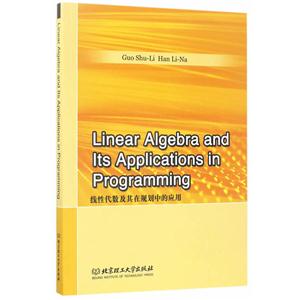Part ⅠChapter 1 Background and Fundamentals of Mathematics1.1 Basic Concepts1.2 Relations1.3 Functions1.4 The Integers1.4.1 Long Division1.4.2 Relatively Prime1.4.3 Prime1.4.4 The Unique Factorization TheoremChapter 2 Groups2.1 Groups2.2 Subgroups2.3 Normal Subgroups2.4 Homomorphisms2.5 Permutations2.6 Product of GroupsChapter 3 Rings3.1 Commutative Rings3.2 Units3.3 The Integers Mod N3.4 Ideals and Quotient Rings3.5 Homomorphism3.6 Polynomial Rings3.6.1 The Division Algorithm3.6.2 Associate3.7 Product of Rings3.8 Characteristic3.9 Boolean RingsChapter 4 Matrices and Matrix Rings4.1 Elementary Operations and Elementary Matrices4.2 Systems of Equations4.3 Determinants4.4 Similarity
Part ⅡChapter 5 Vector Spaces5.1 The Axioms for a Vector Space5.2 Linear Independence,Dimension,and Basis5.3 Intersection,Sum and Direct Sum of Subspaces5.4 Factor Space5.5 Inner Product Spaces5.6 Orthonormal Bases and Orthogonal Complements5.7 Reciprocal Basis and Change of BasisChapter 6 Linear Transformations6.1 Definition of Linear Transformation6.2 Sums and Products of Liner Transformations6.3 Special Types of Linear Transformations6.4 The Adjoint of a Linear Transformation6.5 Component FormulasChapter 7 Determinants And Matrices7.1 The Generalized Kronecker Deltas and the Summation Convention7.2 Determinants7.3 The Matrix of a Linear Transformation7.4 Solution of Systems of Linear Equation7.5 Special MatricesChapter 8 Spectral Decompositions8.1 Direct Sum of Endomorphisms8.2 Eigenvectors and Eigenvalues8.3 The Characteristic Polynomial8.4 Spectral Decomposition for Hermitian Endomorphisms8.5 Illustrative Examples8.6 The Minimal Polynomial8.7 Spectral Decomposition for Arbitrary EndomorphismsChapter 9 Tensor Algebra9.1 Linear Functions,the Dual Space9.2 The Second Dual Space, Canonical Isomorphisms
Part Ⅲ Chapter 10 Linear Programming10.1 Basic Properties of Linear Programs10.2 Many Computational Procedures to Simplex Method10.3 Duality10.3.1 Dual Linear Programs10.3.2 The Duality Theorem10.3.3 Relations to the Simplex Procedure10.4 Interior-point Methods10.4.1 Elements of Complexity Theory10.4.2 The Analytic Center10.4.3 The Central Path10.4.4 Solution StrategiesChapter 11 Unconstrained Problems11.1 Transportation and Network Flow Problems11.1.1 The Transportation Problem11.1.2 The Northwest Comer Rule11.1.3 Basic Network Concepts11.1.4 Maximal Flow11.2 Basic Properties of Solutions and Algorithms11.2.1 First-order Necessary Conditions11.2.2 Second-order Conditions11.2.3 Minimization and Maximization of Convex Functions11.2.4 Zeroth-order Conditions11.2.5 Global Convergence of Descent Algorithms11.2.6 Speed of Convergence11.3 Basic Descent Methods11.3.1 Fibonacci and Golden Section Search11.3.2 Closedness of Line Search Algorithms11.3.3 Line Search11.3.4 The Steepest Descent Method11.3.5 Coordinate Descent Methods11.4 Conjugate Direction Methods11.4.1 Conjugate Directions11.4.2 Descent Properties of the Conjugate Direction Method11.4.3 The Conjugate Gradient Method11.4.4 The C -G Method as an Optimal ProcessChapter 12 Constrained Minimization12.1 Quasi-Newton Methods12.1.1 Modified Newton Method12.1.2 Scaling12.1.3 Memoryless Quasi-Newton Methods12.2 Constrained Minimization Conditions12.2.1 Constraints12.2.2 Tangent Plane12.2.3 First-order Necessary Conditions ( Equality Constraints)12.2.4 Second-order Conditions12.2.5 Eigenvalues in Tangent Subspace12.2.6 Inequality Constraints12.2.7 Zeroth-order Conditions and Lagrange Multipliers12.3 Primal Methods12.3.1 Feasible Direction Methods12.3.2 Active Set Methods12.3.3 The Gradient Projection Method12.3.4 Convergence Rate of the Gradient Projection Method12.3.5 The Reduced Gradient Method12.4 Penalty and Barrier Methods12.4.1 Penalty Methods12.4.2 Barrier Methods12.4.3 Properties of Penalty and Barrier Functions12.5 Dual and Cutting Plane Methods12.5. 1 Global Duality12.5.2 Local Duality12.5.3 Dual Canonical Convergence Rate12.5.4 Separable Problems12.5.5 Decomposition12.5.6 The Dual Viewpoint12.5.7 Cutting Plane Methods12.5.8 Kelley' s Convex Cutting Plane Algorithm12.5.9 Modifications12.6 Primal-dual Methods12.6.1 The Standard Problem12.6.2 Strategies12.6.3 A Simple Merit Function12.6.4 Basic Primal-dual Methods12.6.5 Modified Newton Methods12.6.6 Descent Properties12.6.7 Interior Point Methods
Bibliography

















